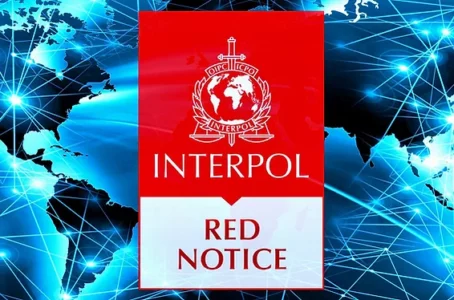
Interpol Lawyers
Have you encountered an Interpol Red Notice? Such situations require immediate and professional action. Our Interpol lawyers have many years of experience in appealing to the Commission for the Control of Files (CCF), defending clients during international searches, and representing them in courts during extradition requests.

We are INTERPOL lawyers
As Interpol Lawyers, our team has provided representation to clients hailing from every corner of the globe. Equipped with the necessary knowledge and expertise, we are dedicated to assisting you in removing your name from INTERPOL’s database.
While it’s not an international arrest warrant, Interpol Red Notices help law enforcement worldwide locate, prosecute, and temporarily arrest a wanted person pending extradition proceedings to the country seeking prosecution. This international alert can seriously restrict a person’s freedom and ability to travel and successfully conduct business. In addition, it can devastate a person’s reputation and cause the closure of bank accounts.
We develop tailored legal strategies considering the peculiarities of national and international law and make every effort to ensure fair consideration of your case. Our qualified Interpol lawyers actively cooperate with national authorities and Interpol to achieve the removal of unlawful notices and protect your reputation, financial and personal interests.
Why do clients choose Interpol-Stop?
In Interpol matters, professional legal assistance is important from lawyers with a deep understanding of international legal norms.
Interpol-Stop is a team of lawyers with many years of experience in appealing notices, protecting clients’ rights, and settling complex cases in the field of international law. Our clients trust us because we offer strategic solutions based on professionalism, confidentiality, and an individual approach.
Our Interpol solicitors have many years of experience working with Interpol notices, which often violate human rights. We understand the intricacies of interaction with the Commission for the Control of Files (CCF), which allows us to successfully challenge unfounded notices.
Each case is unique, so our Interpol lawyers develop personalized defense strategies. We take into account all the details: from the specifics of the charges to national and international legal norms. This approach allows us to achieve the best result for the client.
Anatoly Yarovoy and Dmitry Konovalenko are key figures in our team.
Anatoly Yarovoy is an international lawyer with experience in the most complex and high-profile cases. Master of Laws from Stanford University. Protects clients’ interests in the European Court of Human Rights, Interpol, and other international organizations.
Dmitry Konovalenko is an IBA member lawyer with many years of practice in international law. He has experience in preventing early searches abroad and deals with extradition and Interpol cases. Dmitry has a high reputation among clients due to his ability to effectively resolve even the most complex legal disputes.
We support the client at all stages of the case: from analyzing the situation and filing a request to interacting with national authorities and judicial protection. This guarantees maximum protection of your interests and minimization of possible legal risks.




What is Interpol and what are its functions?
Interpol is an international criminal police organization that helps maintain cooperation between countries in the fight against various crimes. The organization was founded in 1923 in Vienna. Interpol headquarters are located in Lyon, France. The main body is the General Assembly, whose members organize annual meetings, and the General Secretariat specializes in solving current problems.
Currently, the organization has 196 member states. Each member country has its own National Central Bureau (NCB). Interpol’s main task is facilitating international police cooperation and the exchange of information between countries. Additional tasks include:
- combating criminal groups and combating terrorists;
- combating human trafficking and the distribution of child pornography;
- combating the distribution of counterfeit currency, etc.
Interpol has its own Charter, according to which the list of tasks does not include the investigation of cases related to crimes of a political, racial, religious, or military nature.
Search Your Name
NOTE: The majority of red notices are not on the public database. Be careful. The notices are sent to 194 countries. Contact our Interpol lawyers for a free consultation by sending an email to [email protected] and see how you can seek removal of the notice.
INTERPOL keeps a (1) public and (2) private (law enforcement only) list of Red Notices.
How can I get on the Interpol international wanted list?
In practice, it has been proven many times that absolutely anyone can end up on the wanted list. The main reasons for registering personal data about a person in the Interpol system include:
- Commission of serious crimes (concerns especially dangerous criminals).
- Representation of a global threat to society.
- Establishing information about the specific location of persons/persons who are wanted.
- International search for a specific citizen for further extradition.
- Charges related to offenses of international significance.
One of the most common notifications is called a red card. This list often includes businessmen, politicians, civil servants, and other influential persons in power who are active in public life.
Looking for legal advice?
Interpol-Stop is a leading law firm on Interpol issues, working according to international standards. Our specialists have many years of experience in solving complex international legal cases related to Interpol red notices, extradition and cross-border investigations. We provide a comprehensive approach to protecting the rights of our clients, ensuring a high level of professionalism and confidentiality.
What are the risks of being included in the Interpol list?
If your name is on the Interpol list, you may face various legal consequences and potential risks. Such risks have a negative impact on further free movement around the member country/other countries, which calls into question the ability to travel and freely conduct international business.
The main list of consequences:
- negative impact on civil and entrepreneurial positions (inability to conduct business);
- risk of being extradited, difficulties with traveling abroad (up to a ban on leaving the country);
- freezing of bank accounts, a ban on using your own funds;
- risk of being arrested.
To be prepared for any consequences, you will need a lawyer’s consultation. Our international firm offers the opportunity to use legal services right now.
You Are Not Alone
Beyond Red Notices
One of the key tools that allows INTERPOL and national law enforcement agencies to exchange critical information is notices. The notice system is designed to simplify the search for suspects or wanted persons, search for missing persons, and prevent international threats.
Each notice has its own color, indicating the purpose and priority of execution, but they all serve a single task – to facilitate the fight against crime at the global level. Instead of lengthy diplomatic procedures, states only need to send a request for the placement of a notice, and it becomes available in the INTERPOL I-24/7 network, coordinating national bureaus and services.
Green Notice
A Green Notice is used to inform member countries about the criminal activity of a suspect who may pose a potential threat to others. Consequences of a Green Notice: travel restrictions abroad, dissemination of negative information in the media.
Yellow Notices
Yellow Notice is used to request the location of a missing person and to search for data to identify him. Consequences of a yellow card: problems with traveling abroad.
Blue Notice
Blue Notice is used to obtain additional information about the exact location of a suspect. Consequences of a blue card: the suspect is placed under surveillance, observation.
Diffusion
Interpol Diffusion, like Red Notices, can be issued to one or more countries, rather than to all Interpol member countries.
Preemptive Requests
When our clients are afraid that they may be placed on Red Notice, we begin constructing their cases and contact INTERPOL before an arrest order is issued.
Red Notice
Red Notice is used for the purpose of international search, detention for further extradition of the suspect. Consequences of the red card: high risk of being arrested at home or while traveling (crossing borders).
Extradition
Specialized legal assistance with extradition cases. Our lawyers provide legal advice and defense strategies to navigate the extradition process.
Global Personal Data Checks & Corrections
We help our clients keep their information straight by correcting erroneous data collected by companies.
What to do if you are wanted by Interpol and under threat of criminal prosecution?
Learning that your name is in the Interpol database is an extremely unexpected and stressful event. However, it does not mean immediate arrest or imminent extradition.
First of all, you need to clarify the status and check the notification. Visit the official Interpol website to view the open database. However, it is worth considering that not all notifications are published publicly. If you received a notification from official sources or from law enforcement agencies, it is important to find out the details (type of notification, circumstances of the case).
Contact experienced lawyers as soon as possible. A professional lawyer will help you find out on what grounds you are wanted and what are the ways to appeal the notification. A lawyer will ensure that your rights are respected, minimize the risk of erroneous actions, and protect you from incorrect statements that can be used against you.
Our lawyers specialize in Interpol cases and have successful experience in appealing notifications before the Commission for the Control of Files. We analyze each client’s situation in detail, developing a personalized extradition defence strategy.
The next step is collecting information and documents. If the charges are unfounded, collect evidence to support your alibi, as well as possible evidence of biased motivation for the notification. It is important to confirm the legality of your actions, financial transactions, or business activities.
Find out in which member country the criminal prosecution was initiated, at what stage the investigation is, and which articles apply.
If you have a red notice, you may be detained at the airport or when trying to cross the border. A lawyer will help you find out which countries have the highest risk of detention. Agree on an action plan with your lawyer in advance: what to do when meeting with law enforcement agencies, what documents and contacts to have with you.
After this, you must file an appeal against the notice with the Commission for the Control of Files. The CCF may remove the notice if it violates Interpol principles, particularly if it suggests a political nature or does not meet the “double criminality” requirement.
We prepare a detailed package of documents and arguments in defense of the client. In case of refusal, we may submit additional information or use other means of protection at the national and international levels.
We Plan Accordingly
Legal Services of Lawyers
Our international firm offers a professional approach from a team of qualified lawyers in solving issues related to Interpol legal framework.
Many successful cases and satisfied clients prove our professionalism, and the ability to solve problems of any legal complexity.
Appealing a search
To protect the rights and interests of clients, an international lawyer appeals a search. The procedure takes place in several stages. The decision-making period depends on the specified requirements: for example, for access to data - 4 months, correction/deletion of information - up to 9 months.
Legal support
A team of qualified lawyers specializes in extradition, resolving cases related to Interpol's constitution. We can take the necessary measures, both at an early stage of the case, and in case of political, economic, and other charges.
Extradition Protection
Interpol-Stop offers high-quality international protection of interests for each client, providing strategically correct legal advice. Our main task is to protect fundamental human rights and minimize the risks of international criminal prosecution by removing Interpol notices.
What additional legal services do Interpol lawyers provide?
Our company specializes in solving complex international legal issues. We provide a wide range of services to protect your rights and interests in various jurisdictions around the world. Below is an overview of the key areas that our lawyers successfully handle.
Internationally Wanted
We advise and represent clients who have come to the attention of Interpol or other international structures. Our lawyers verify information about the wanted list, determine its legality and develop a strategy to minimize risks. We protect clients from unlawful prosecution, interact with national and international authorities, and achieve exclusion from Interpol databases in case of inconsistency of charges with the actual facts.
Extradition
The extradition process can be complex and confusing, especially if you or your business is involved in a case involving several countries. Our lawyers analyze the legality of the extradition request, prepare arguments for the defense, and work to prevent the unjustified extradition of the client. We support you at all stages: from analyzing international treaties to appealing the decision in higher courts.
Removing an INTERPOL Red Notice
A Red Notice can create serious obstacles to travel, work, and reputation. We challenge these notices by filing appeals to the CCF and providing evidence of the notice’s inconsistency with the INTERPOL Charter. Our lawyers know the algorithm of actions and achieve full rehabilitation of the client, the removal of the notice, and the restoration of his rights.
Removing SIS alert
The Schengen Information System is used in Europe to exchange information on wanted persons and security warnings. Having an SIS alert can restrict your stay in the EU countries. We help clients challenge unfounded notices, interact with EU national authorities, and ensure the protection of the rights to free movement and entrepreneurial activity.
Preventive request to INTERPOL
To avoid sudden blocking or detention when crossing the border, we recommend filing a preventive request to INTERPOL. Our lawyers check whether your name or company is in wanted databases and help to quickly eliminate possible problems. This allows you to learn about potential claims in advance and prepare a defense strategy.
We successfully resolve cross-border cases involving typical international crimes and protect clients in various jurisdictions. Our employees accompany clients from the initial consultation to the full resolution of the issue. If you are faced with any issues of the international legal system, contact our team. We will provide comprehensive solutions and ensure professional protection of your interests.

FAQ
Appeals against red notices are made through the Commission for the Control of Interpol's Files. To successfully appeal, it is necessary to provide evidence that the notice violates the Interpol charter, is based on political, military, racial, or religious motives, or does not comply with international legal standards. Interpol Advocate will help prepare a legal basis for the client's defense.
The CCF is an independent body responsible for protecting the rights of individuals in relation to data stored in INTERPOL systems. The Commission for the Control of INTERPOL's Files reviews complaints about Red Notices, and checks their compliance with the statute and legal provisions. If the complaint is found to be justified, the CCF may initiate the removal of the notice from the database.
A lawyer for Interpol matters must have a thorough knowledge of international criminal law and the Organization's procedures. Extensive experience in appealing notices through the CCF and interacting with national authorities is also a prerequisite. The lawyer must be able to develop effective defense strategies taking into account both national and interpol regulations.
A Red Notice may be removed if it violates the INTERPOL Charter, is based on unlawful or false allegations, violates fair trial principles, or for other reasons.
An international search through Interpol can be initiated if the crime is international, the offender has left the country's territory to evade justice, or if the requesting country contacts Interpol to notify other states of the need to detain or provide information on the location of a person.








